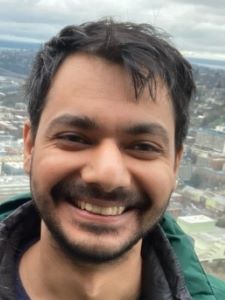Gaurav Chaudhary

Dr Gaurav Chaudhary
Research Fellow at Clare Hall College
Postdoc in Dr Slager's group
Office: 544 Mott Bld
Email: gc674 @ cam.ac.uk
ORCID: 0000-0002-1275-3400
TCM Group, Cavendish Laboratory
19 JJ Thomson Avenue,
Cambridge, CB3 0HE UK.
Research
I am generally interested in the systems where interplay between band topology and electron-electron correlations can lead to emergent quantum phenomena. An excellent example of such phenomena is topological superconductivity, which has rich fundamental physics as well as great applications for future quantum technology because of the robustness it inherits from topology. One of the many proposed scenarios in which superconductivity can become topological is when electrons that pair to lead to superconductivity come from topological bands, such as Landau levels. I have shown that in this setting the topological classification of the superconductor is dictated by how the vortices in the superconducting order are arranged. In terms of physical systems, my recent focus has been on the newly discovered moiré materials. These engineered materials are characterized by the long length-scale “moiré modulation” produced by a small mismatch between two layers of material. Importantly, the moire modulation makes these new materials an exciting playground for topology and correlations, opening up a plethora of possibilities for novel quantum phenomena. A full list of my publications can be found on ORCID .
In Plain English
Why do magnets attract each other? How does electricity flow in superconductors without energy loss? To answer these questions, we need to understand the quantum mechanics of materials.
Materials are made up of countless electrons that interact with each other and the atomic nuclei, following the laws of quantum mechanics. Even though these laws have been known for decades, the complexity of many interacting particles makes it impossible to solve them. This complexity is also the source of beautiful phenomena such as magnetism and superconductivity. Fortunately, by understanding how the nuclei are arranged and how two electrons interact at a time, we can develop simpler equations that are good enough to make experimentally verifiable predictions.
If we can control the arrangement of the nuclei and interactions, we can tune and find new quantum phenomena. Such control is “effectively” possible in newly discovered moiré materials, where a slight mismatch between two layers of material creates a “moiré modulation”. This modulation is similar to the musical beats produced by mixing sounds from different instruments. A key theme of my current research lies in exploiting the moiré modulation and performing calculations to predict new quantum phenomena in moiré materials.
Featured Publications
Polar meron-antimeron networks in twisted bilayers. Daniel Bennett, Gaurav Chaudhary, Robert-Jan Slager, Eric Bousquet, Philippe Ghosez, Nat. Commun. 14 , 1629 (2023)
Twisted bilayers of thin film magnetic topological insulators. Gaurav Chaudhary, Anton A. Burkov, and Olle G. Heinonen, Phys. Rev. Res. 4 , 043034 (2022)
Quantum Hall superconductivity from moiré Landau levels. Gaurav Chaudhary, Allan H. MacDonald, and Michael R. Norman Phys. Rev. Res. 3 , 033260 (2021)
Multiple Flat Bands and Topological Hofstadter Butterfly in Twisted Bilayer Graphene Close to the Second Magic Angle. X. Lu, B. Lian, G. Chaudhary et. al., PNAS 118 (30) , e2100006118 (2021)
Vortex Lattice Structure and Topological Superconductivity in the Quantum Hall Regime. Gaurav Chaudhary and Allan H. MacDonald, Phys. Rev. B 101 , 024516 (2020)